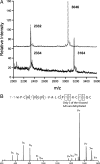Discovery and in vitro biosynthesis of haloduracin, a two-component lantibiotic
- PMID: 17085596
- PMCID: PMC1859917
- DOI: 10.1073/pnas.0606088103
Discovery and in vitro biosynthesis of haloduracin, a two-component lantibiotic
Abstract
Lantibiotics are ribosomally synthesized peptides that undergo posttranslational modifications to their mature, antimicrobial form. They are characterized by the unique amino acids lanthionine and methyllanthionine, introduced by means of dehydration of Ser/Thr residues followed by reaction of the resulting dehydro amino acids with cysteines to form thioether linkages. Two-component lantibiotics use two peptides that are each posttranslationally modified to yield two functionally distinct products that act in synergy to provide bactericidal activity. By using genetic data instead of isolation, a two-component lantibiotic, haloduracin, was identified in the genome of the Gram-positive alkaliphilic bacterium Bacillus halodurans C-125. We show that heterologously expressed and purified precursor peptides HalA1 and HalA2 are processed by the purified modification enzymes HalM1 and HalM2 in an in vitro reconstitution of the biosynthesis of a two-component lantibiotic. The activity of each HalM enzyme is substrate-specific, and the assay products exhibit antimicrobial activity after removal of their leader sequences at an engineered Factor Xa cleavage site, indicating that correct thioether formation has occurred. Haloduracin's biological activity depends on the presence of both modified peptides. The structures of the two mature haloduracin peptides Halalpha and Halbeta were investigated, indicating that they have similarities as well as some distinct differences compared with other two-component lantibiotics.
Conflict of interest statement
The authors declare no conflict of interest.
Figures





Similar articles
-
Structure-activity relationship studies of the two-component lantibiotic haloduracin.Chem Biol. 2008 Oct 20;15(10):1035-45. doi: 10.1016/j.chembiol.2008.07.020. Chem Biol. 2008. PMID: 18940665 Free PMC article.
-
Synergistic binding of the leader and core peptides by the lantibiotic synthetase HalM2.ACS Chem Biol. 2015 Apr 17;10(4):970-7. doi: 10.1021/cb5009876. Epub 2015 Feb 4. ACS Chem Biol. 2015. PMID: 25619528 Free PMC article.
-
Pseudomycoicidin, a Class II Lantibiotic from Bacillus pseudomycoides.Appl Environ Microbiol. 2015 May 15;81(10):3419-29. doi: 10.1128/AEM.00299-15. Epub 2015 Mar 13. Appl Environ Microbiol. 2015. PMID: 25769830 Free PMC article.
-
Lantibiotics: mode of action, biosynthesis and bioengineering.Curr Pharm Biotechnol. 2009 Jan;10(1):2-18. doi: 10.2174/138920109787048616. Curr Pharm Biotechnol. 2009. PMID: 19149587 Review.
-
Lantibiotics: peptides of diverse structure and function.Annu Rev Microbiol. 2007;61:477-501. doi: 10.1146/annurev.micro.61.080706.093501. Annu Rev Microbiol. 2007. PMID: 17506681 Review.
Cited by
-
Improved methods for genetic manipulation of the alkaliphile Halalkalibacterium halodurans.Front Microbiol. 2024 Sep 18;15:1465811. doi: 10.3389/fmicb.2024.1465811. eCollection 2024. Front Microbiol. 2024. PMID: 39360312 Free PMC article.
-
Mechanistic Analysis of the Biosynthesis of the Aspartimidylated Graspetide Amycolimiditide.J Am Chem Soc. 2022 Nov 30;144(47):21628-21639. doi: 10.1021/jacs.2c09004. Epub 2022 Nov 17. J Am Chem Soc. 2022. PMID: 36394830 Free PMC article.
-
Thusin, a Novel Two-Component Lantibiotic with Potent Antimicrobial Activity against Several Gram-Positive Pathogens.Front Microbiol. 2016 Jul 19;7:1115. doi: 10.3389/fmicb.2016.01115. eCollection 2016. Front Microbiol. 2016. PMID: 27486447 Free PMC article.
-
Identification of a novel two-peptide lantibiotic, lichenicidin, following rational genome mining for LanM proteins.Appl Environ Microbiol. 2009 Sep;75(17):5451-60. doi: 10.1128/AEM.00730-09. Epub 2009 Jun 26. Appl Environ Microbiol. 2009. PMID: 19561184 Free PMC article.
-
Substrate Recognition by the Class II Lanthipeptide Synthetase HalM2.ACS Chem Biol. 2020 Jun 19;15(6):1473-1486. doi: 10.1021/acschembio.0c00127. Epub 2020 Apr 28. ACS Chem Biol. 2020. PMID: 32293871 Free PMC article.
References
-
- Delves-Broughton J, Blackburn P, Evans RJ, Hugenholtz J. Antonie van Leeuwenhoek. 1996;69:193–202. - PubMed
-
- Cotter PD, Hill C, Ross RP. Nat Rev Microbiol. 2005;3:777–788. - PubMed
-
- Chatterjee C, Paul M, Xie L, van der Donk WA. Chem Rev. 2005;105:633–684. - PubMed
-
- Schnell N, Entian K-D, Schneider U, Götz F, Zahner H, Kellner R, Jung G. Nature. 1988;333:276–278. - PubMed
-
- van der Meer JR, Rollema HS, Siezen RJ, Beerthuyzen MM, Kuipers OP, de Vos WM. J Biol Chem. 1994;269:3555–3562. - PubMed
Publication types
MeSH terms
Substances
Grants and funding
LinkOut - more resources
Full Text Sources
Other Literature Sources
Molecular Biology Databases

